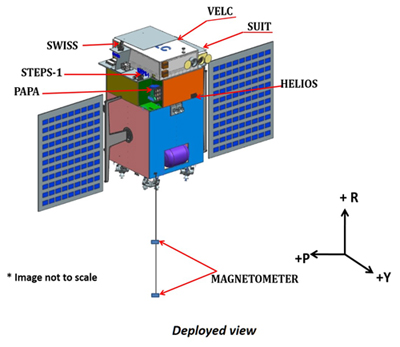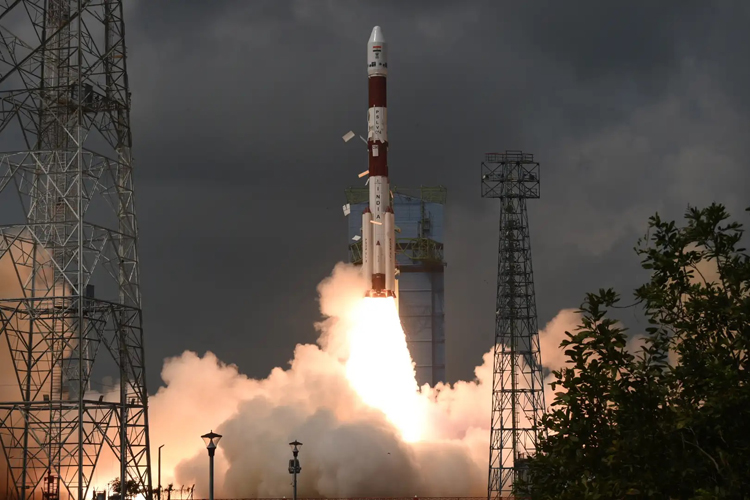INDIAN ARMED FORCES CHIEFS ON
OUR RELENTLESS AND FOCUSED PUBLISHING EFFORTS

SP Guide Publications puts forth a well compiled articulation of issues, pursuits and accomplishments of the Indian Army, over the years

I am confident that SP Guide Publications would continue to inform, inspire and influence.

My compliments to SP Guide Publications for informative and credible reportage on contemporary aerospace issues over the past six decades.
- Prime Minister witnesses 'Bharat Shakti' – a Tri-Services Firing and Manoeuvre Exercise in Pokhran, Rajasthan
- Interim Defence Budget 2024-25 — An Analysis
- Union Defence budget 2024
- Prime Minister Modi Commemorates Indian Navy Day in a Grand Ceremony
- Prime Minister Modi Flies in the LCA Tejas
- New Chapter in India-Italy Defence Ties
- Airpower beyond Boundaries
Aditya-L1 Mission
The scope of the mission has been expanded and it is now planned to be a comprehensive solar and space environment observatory to be placed at the L1 point
 |
The Author is Former Director General of Information Systems and A Special Forces Veteran, Indian Army |

The Solar System has been the object of curiosity for humans since times immemorial. The world witnessed the first satellite ‘Sputnik’ launched by the Soviet Union on October 4, 1957. This was followed by launch of the US satellite ‘Explorer’ on January 31, 1958. According to the Index of Objects Launched into Outer Space, maintained by the United Nations Office for Outer Space Affairs (UNOOSA), by the end of January 2022, there were 12,293 objects launched into the space.
ISRO Chairman said that the Polar Satellite Launch Vehicle (PSLV) will be used for a mission to the Sun in 2023 for deploying the Aditya-L1 satellite; a coronagraphic spacecraft to study the solar atmosphere.
Every celestial body, including Earth and the exoplanets outside the Solar System, is regulated by its parent star, which in our case is the Sun. The sun is Earth's closest stellar neighbour, the distance between the two being around 15 crore km. For scientists to understand the behaviour of the Sun, including how the radiation emanating from it can affect astronauts or satellites in space, numerous probes have been sent to the Sun.
Some of the missions sent to the Sun include: ‘Solar Maximum Mission’ (1980-1989) - launched by NASA; ‘Ulysses’ (1990-2009) - joint launch by the European Space Agency (ESA) and NASA; ‘Yohkoh’ (1991-2001) - launched by the Japanese Aerospace Exploration Agency (JAXA); ‘Soho’ (1995-2017) - jointly launched by ESA and NASA; ‘TRACE’ (1998-2010) - launched by NASA; ‘Genesis’ - launched by NASA (2001-2004); ‘Hinode’ - launched in 2006 by JAXA and remains active; ‘STEREO’- launched by NASA in 2006 is partially active since contact with one spacecraft out of the two was lost in 2016; ‘SDO’ – launched by NASA in 2010 remains active, and; 'IRIS’- launched by NASA in 2013 remains active.

The successful launch of the Indian Space Research Organisation’s (ISRO’s) PSLV-C54 carrying the India-Bhutan SAT, along with India’s Earth Observation Satellite-06 and other satellites from Satish Dhawan Space Centre in Sriharikota on November 26, 2022 has been covered in these columns elsewhere. ISRO Chairman S. Somanath has now said that the Polar Satellite Launch Vehicle (PSLV) will be used for a mission to the Sun in 2023 for deploying the Aditya-L1 satellite; a coronagraphic spacecraft to study the solar atmosphere. He has said that the spacecraft will be placed in a halo orbit around the first Lagrange Point, L1, of the Sun-Earth system, enabling it to continuously view the sun without occultation or eclipses.
The spacecraft will be placed in a halo orbit around the first Lagrange Point, L1, of the Sun-Earth system, enabling it to continuously view the sun without occultation or eclipses.
The ‘Aditya’ mission was conceptualised in January 2008 by the Advisory Committee for Space Research. It was initially envisaged as a small 400 kg low-Earth orbiting satellite to study the solar corona with an experimental budget of 3 crore allocated for FY 2016–2017. However, the scope of the mission has since been expanded and it is now planned to be a comprehensive solar and space environment observatory to be placed at the L1 point. The mission was renamed ‘Aditya-L1’ and in July 2019 the mission has an allocated cost of 378.53 crore excluding launch costs. The Aditya-L1 mission is expected to take around 109 Earth days after launch to reach the halo orbit around the L1 point.
The seven onboard payloads of Aditya L1 will include:
- Visible Emission Line Coronagraph (VELC) weighing nearly 179 kg and having capability of spectral imaging of the corona in visible and infra-red (IR) wavelengths;
- Solar Ultraviolet Imaging Telescope (SUIT) weighing nearly 35 kg to observe the Sun between 200-400 nm wavelength range and provide full disk images of different layers of the solar atmosphere – the Sun has never been observed from space in this wavelength range;
- Aditya Solar wind Particle Experiment (ASPEX) to study the variation and properties of the solar wind as well as its distribution and spectral characteristics;
- Plasma Analyser Package for Aditya (PAPA) to understand the composition of solar wind and its energy distribution;
- Solar Low Energy X-ray Spectrometer (SoLEXS) to monitor the X-ray for studying the enigmatic corona heating mechanism of the solar corona;
- High Energy L1 Orbiting X-ray Spectrometer (HEL1OS) to observe the dynamic events in the solar corona and provide an estimate of the energy used to accelerate the solar energetic particles during the eruptive events, and;
- Magnetometer to measure the magnitude and nature of the interplanetary magnetic field.
According to news reports of October 10, 2022, China has launched its observatory for the sun, nicknamed ‘Kuafu-1’, from the Jiuquan Satellite Launch Center in northwest China, to study the causality between the solar magnetic field and two major eruptive phenomena: solar flares and coronal mass ejections. The observatory weighing about 859 kg has been placed in an orbit about 720 km above the planet, higher than the orbit of the International Space Station. It has three major instruments onboard; Lyman-alpha Solar Telescope (LST), Hard X-ray Imager (HXI) and the Full-disk Vector MagnetoGraph (FMG).
Aditya-L1 mission will enable a comprehensive understanding of the dynamical processes of the Sun and address some of the outstanding problems in solar physics and heliophysics
Kuafu-1 has a six-month commissioning phase while in orbit, after which science operations will commence. The scientific objective for the mission has been described as 1M2B, where M refers to the solar magnetic field and two Bs are for two violent bursts, the solar flares and coronal mass ejections (CMEs). Designed to remain in service for four years, the mission is to beam back about 500 gigabytes of data every day. It will reportedly probe the Sun 24 hours daily for most of the year, with its longest daily time-out about 18 minutes when running through the shadow of Earth each day from May to August.
Interestingly, the Solar and Heliospheric Observatory Satellite (SOHO) jointly launched by ESA and NSA, as mentioned above, is also housed at the L1 point, which is part of an international partnership between the two agencies. India’s Aditya-L1 mission will enable a comprehensive understanding of the dynamical processes of the Sun and address some of the outstanding problems in solar physics and heliophysics.





